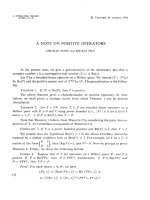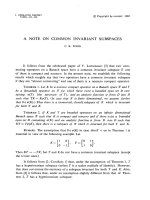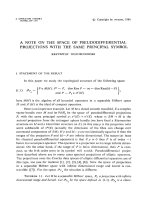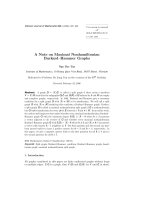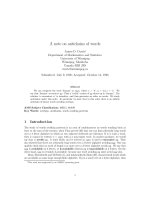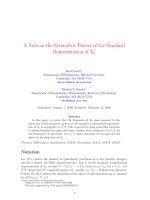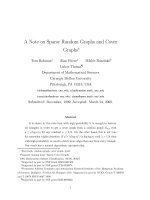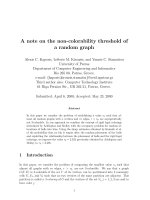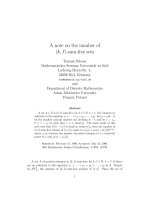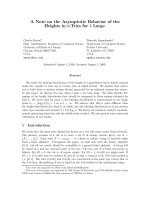Báo cáo toán học: "A note on constructing large Cayley graphs of given degree and diameter by voltage assignments" pdf
Bạn đang xem bản rút gọn của tài liệu. Xem và tải ngay bản đầy đủ của tài liệu tại đây (132.9 KB, 11 trang )
A note on constructing large Cayley graphs of given
degree and diameter by voltage assignments
∗
Ljiljana Brankovi´c, Mirka Miller
Department of Computer Science and Software Engineering,
The University of Newcastle NSW 2308 Australia,
e-mail: {lbrankov,mirka}@cs.newcastle.edu.au
J´an Plesn´ık
Department of Numerical and Optimization Methods,
Faculty of Mathematics and Physics,
Comenius University, 842 15 Bratislava, Slovakia,
e-mail:
Joe Ryan
Department of Mathematics,
The University of Newcastle NSW 2308 Australia,
e-mail:
Jozef
ˇ
Sir´aˇn
Department of Mathematics,
SvF Slovak Technical University
Radlinsk´eho 11, 813 68 Bratislava, Slovakia,
e-mail:
Submitted: July 7, 1997; Accepted: August 8, 1997.
Abstract
Voltage graphs are a powerful tool for constructing large graphs (called
lifts) with prescribed properties as covering spaces of small base graphs. This
makes them suitable for application to the degree/diameter problem,whichis
to determine the largest order of a graph with given degree and diameter.
Many currently known largest graphs of degree ≤ 15 and diameter ≤ 10 have
been found by computer search among Cayley graphs of semidirect products
of cyclic groups. We show that all of them can in fact be described as lifts of
smaller Cayley graphs of cyclic groups, with voltages in (other) cyclic groups.
∗
This research started when J. Plesn´ık and J.
ˇ
Sir´aˇn were visiting the Department of Computer
Science and Software Engineering of the University of Newcastle NSW Australia in 1995, supported
by small ARC grant.
1
the electronic journal of combinatorics 5 (1998), #R9 2
This opens up a new possible direction in the search for large vertex-transitive
graphs of given degree and diameter.
AMS Subject Classification: 05C25.
1 Introduction
The problem of finding, for given d and k, the largest order n
d,k
of a graph of maximum
degree d and diameter ≤ k is well known as the degree/diameter problem.Anobvious
upper bound on n
d,k
is the Moore bound M
d,k
, named after E. F. Moore who first
proposed the problem (see [20]): n
d,k
≤ M
d,k
=1+d+d(d−1) + +d(d−1)
k−1
.
The equality n
d,k
= M
d,k
holds only if (a) k = 1 and d ≥ 1, or (b) k = 2 and d =2, 3,7
(and, possibly, d = 57), or (c) k ≥ 3andd= 2; see [20, 8, 1]. For all remaining values
of d and k the best known general upper bound [2, 12] is n
d,k
≤ M
d,k
− 2, which was
recently improved see [21] for trivalent graphs and k ≥ 4ton
3,k
≤ M
3,k
− 4.
In the absence of better upper bounds a number of clever methods for construct-
ing large graphs of given degree and diameter have been proposed. We just mention
here various compounding operations [15], twisted product of graphs [3], polarity quo-
tients [9], and linear congruential graphs [23]; others are listed in [19] and references
therein. For computer search results we refer to [11, 19]. An updated list of currently
largest known graphs of degree d and diameter k for d ≤ 15 and k ≤ 10 is maintained
in [10]. For our purposes it is important to point out that, for d ≤ k, about a half of
the values in the list have been obtained by searching over Cayley graphs of semidi-
rect products of (mostly cyclic) groups. Actually, this fact has led to the introduction
of the vertex-transitive version of the degree/diameter problem, which is finding the
largest order ν
d,k
of a vertex-transitive graph of degree d and diameter k.
Quite recently the current authors have argued [6] that the covering graph con-
struction has a very good potential for producing examples of large graphs of given
degree and diameter. Roughly speaking, this method enables to “blow up” a given
base graph to a larger graph (called lift)whichisaregular covering space of the base
graph. The lift is best described in terms of the base graph and a mapping, called
voltage assignment, which endows (directed) edges of the base graph with elements of
a finite group. A self-contained introduction to the topic is provided in Section 2. As
shown in [6], many of the currently known largest examples of graphs of given degree
and diameter can indeed be obtained by the covering graph construction. Further, a
recent result of [22] which shows that ν
d,2
≥
8
9
(d +
1
2
)
2
for all d =(3q−1)/2 such that
q =4+ 1 is a prime power was also obtained using voltage assignments.
The objective of this paper is to show that, in fact, all the Cayley graphs of
semidirect products of groups which appear in the tables of largest known graphs of
given degree and diameter [11, 19, 10] can be described as covering spaces of smaller
base graphs, with voltage assignments taken in groups with a simpler structure; see
Sections 4 and 5. (This of course does not exclude the possibility of finding – by
computer search or other methods – even larger Cayley graphs based on groups which
the electronic journal of combinatorics 5 (1998), #R9 3
are not semidirect products.) We also include some observations on vertex-transitivity
of a lift (Section 3).
2 Voltage assignments and lifts
Voltage assignments on graphs were formally introduced in 1974 [16] as a dualisation
of the current graphs theory, which was the basic tool in the proof of the famous
Heawood Map Color Theorem [26]. It turns out that (ordinary) voltage assignments
on graphs are, in a sense, equivalent to semiregular groups of graph automorphisms
(see Theorem 2.2.2 of [17]); since the latter were used in [13] for a concise description
of certain graphs, this paper can also be seen as an ancestor for voltage graphs.
The theory of voltage graphs and their lifts can be viewed as a discretization of the
well known theory of covering spaces in algebraic topology applied to 1-dimensional
cell complexes, i.e., graphs. (There are other viewpoints as well, known as theory
of quotient graphs or divisors [7], equitable partitions [28], or colorations [24].) The
covering graph technique itself appears frequently as a tool in algebraic combinatorics;
we may mention e.g., the computation of spectra of covering graphs [7, 14], the theory
of distance-regular graphs [14], a construction of infinitely many cubic 5-arc-transitive
graphs [4], or constructions of cages [5].
An excellent treatment of the theory of voltage graphs and their applications in
constructing surface embeddings (including a voltage-based view of the Map Color
Theorem) can be found in [17]; for a more algebraic viewpoint see also Chapter
19 of [4]. In order to make this paper self-contained and accessible for readers not
acquainted with the theory, we sum up the basics in what follows.
Let G be an undirected graph, which may have loops and/or parallel edges. We
also allow G to have semi-edges, that is, dangling edges with just one end incident
to a vertex of G. (The occurence of the above three types of degeneracies may not
be natural at a first glance but it is well accepted – and sometimes unavoidable –
in algebraic graph theory.) Although the graph G itself is undirected, it will be of
advantage to assign (for auxiliary purposes) directions to its edges. An edge with
an assigned direction will be called an arc. Clearly, each edge of G which is not a
semiedge gives rise to a pair of mutually reverse arcs. The reverse of an arc e will be
denoted e
−1
; it is understood that (e
−1
)
−1
= e. A semiedge will have, by definition,
only one direction, outward of the incident vertex (which is considered to be both
initial as well as terminal vertex of the semiedge). For convenience, if e is an arc
arising from a semiedge we still may formally use the symbol e
−1
but we set e = e
−1
in such a case. The collection of all possible arcs of G will be denoted by D(G).
Let Γ be a group and let G be a graph. A mapping α : D(G) → Γ will be called
a voltage assignment on G if, for each arc e ∈ D(G), α(e
−1
)=(α(e))
−1
. It follows
that (α(e))
2
= id if e is an arc corresponding to a semiedge.
In order to specify a voltage assignment in a pictorial representation of a graph, we
usually fix in advance an orientation of the (undirected) graph G and assign voltages
the electronic journal of combinatorics 5 (1998), #R9 4
to the arcs obtained; the reverse arcs are assumed to carry the corresponding inverse
voltages.
Let α : D(G) → Γ be a voltage assignment on a graph G in a group Γ. We now
introduce the concept of a lift G
α
of the graph G. The vertex set and the arc set of
the lift are V (G
α
)=V(G)×ΓandD(G
α
)=D(G)×Γ; we shall use subscripts for
the Γ-coordinates of ordered pairs. The incidence in the lift is defined as follows. For
any arc e from u to v in G and any g ∈ Γ there is exactly one arc e
g
in the lift G
α
;
this arc emanates from the vertex u
g
and terminates at the vertex v
gα(e)
.
Observe that, in agreement with the definition, the arc (e
−1
)
gα(e)
of the lift G
α
emanates from v
gα(e)
and terminates at u
g
, because α(e
−1
)=(α(e))
−1
. The pair of
arcs e
g
and (e
−1
)
gα(e)
constitutes an undirected edge of the lift G
α
; for the reverse
arcs in the lift we therefore have (e
g
)
−1
=(e
−1
)
gα(e)
.
Let π : G
α
→ G be the natural projection which erases the subscripts, that is,
π(u
g
)=uand π(e
g
)=efor each u ∈ V (G), e ∈ D(G)andg∈Γ. Clearly, π is a
graph homomorphism; the sets π
−1
(u)andπ
−1
(e) are called fibres above the vertex
u or above the arc e, respectively. Thus, if e is an arc from u to v and if u = v,then
the arcs in π
−1
(e) constitute a matching between the fibres π
−1
(u)andπ
−1
(v). If e
is a loop-arc at u then the arcs in π
−1
(e) induce |Γ|/k vertex-disjoint directed cycles
on the set π
−1
(u)wherekis the order of α(e) in Γ. Finally, if e is a semiedge-arc at
u then π
−1
(e) induces either a set of |Γ| semiedges (if α(e)=id) or a matching on
π
−1
(u)(ifα(e) has order two in Γ).
Many properties of the lift can be identified by examining walks in the base graphs;
examples will be given in Lemma 1 and in Theorem 1. We recall that a walk of length
m in a graph G is a sequence W = e
1
e
2
e
m
where e
i
are arcs of G, such that
the terminal vertex of e
i−1
is the same as the initial vertex of e
i
,2≤i≤m.We
say that W is a u − v walk if u is the initial vertex of e
1
and v is the terminal
vertex of e
m
.Ifu=vthen the walk W is said to be closed,orclosed at u.Ifα
is a voltage assignment on G, then the net voltage of W is defined as the product
α(W )=α(e
1
)α(e
2
) α(e
m
).
For a much more detailed exposition of the theory of voltage assignments and lifts
we refer to [17]. We conclude this Section by illustrating the concepts introduced
above in the following useful observation (cf. [6]).
Lemma 1 Let α be a voltage assignment on a graph G inagroupΓ. Then, diam(G
α
)
≤ k if and only if for each ordered pair of vertices u, v (possibly, u = v)ofGand for
each g ∈ Γ there exists a u − v walk of length ≤ k of net voltage g.
Proof. For any two distinct vertices u
g
and v
h
in V (G
α
), there exists a walk
˜
W
of length at most k from u
g
to v
h
if and only if the projection W = π(
˜
W )isawalk
inthebasegraphGof length at most k from u to v with α(W )=g
−1
h. (The case
when both u = v and g = h follows by considering closed walks of zero length.)
the electronic journal of combinatorics 5 (1998), #R9 5
3 Lifts of graph automorphisms
In what follows we outline a method for finding voltage assignments which make the
lift vertex-transitive (provided that the base graph is).
First, observe that for any two vertices u
g
and u
h
inthesamefibreπ
−1
(u)there
exists an automorphism of the lift which sends u
g
to u
h
. Indeed, if r = hg
−1
,the
mapping
˜
B
r
: G
α
→ G
α
,givenby
˜
B
r
(v
s
)=v
rs
for each v
s
∈ V (G
α
), is an auto-
morphism of the lift G
α
such that
˜
B
r
(u
g
)=u
h
. Therefore, Aut(G
α
), the group of
all automorphisms of G
α
, acts transitively on each fibre, and hence we always have
|Aut(G
α
)|≥|Γ|. In fact, the insertion r →
˜
B
r
yields a regular action of the voltage
group Γ on the lift. In algebraic topology, lifts as introduced in Section 2 are called
regular covering spaces; the adjective regular comes from the regular action described
above.
Further automorphisms of the lift may sometimes be obtained from automor-
phisms of the base graph. We say that an automorphism A of G lifts to an au-
tomorphism
˜
A of G
α
if π
˜
A = Aπ,thatis,ifπ(
˜
A(v
h
)) = A(π(v
h
)) for each vertex
v
h
∈ G
α
. Note that A(π(v
h
)) = A(v), and hence the lifted automorphism
˜
A maps
vertices from the fibre π
−1
(v) onto vertices in the fibre π
−1
(A(v)); in other words,
˜
A
is fibre-preserving. Also, observe that if an automorphism A ∈ Aut(G) lifts to some
˜
A ∈ Aut(G
α
), then A has at least |Γ| distinct lifts. This is due to the fact that for
each r ∈ Γ, the composition
˜
B
r
˜
A is a lift of A as well, because π
˜
B
r
˜
A = π
˜
A.(Observe
that the automorphisms
˜
B
r
themselves are lifts of the identity automorphism of G.)
The following theorem was proved in [18] in a map-theoretical setting; for a graph-
theoretical proof see [25].
Theorem 1 Let G be a connected graph, let α be a voltage assignment on G in a
finite group Γ, and let A be an automorphism of G. Then, A lifts to an automorphism
of G
α
if and only if for any closed walk W at a fixed vertex of G we have α(W )=
id ⇔ α(A(W )) = id.
At a first glance, this result may seem not easily applicable, because it involves
checking all closed walks. However, there is an easy way to reduce the checking to
a number of walks proportional to the number of edges of G; see [25] for details.
Moreover, the structure of the base graph G may sometimes be simple enough to
check the above condition directly. An example of such a situation can be found
in [22] where vertex-transitivity of the lifts follows from Theorem 1 (although in [22]
a different method was used).
Here we state and prove two useful corollaries of Theorem 1 which we shall need
later and where the amount of checking is reduced to a minimum.
Corollary 1 Let G be a connected graph and let A be a group of automorphisms of G.
Let Γ be a voltage group and let φ : A→Aut(Γ) be an arbitrary group homomorphism
which sends each graph automorphism A ∈Ato an automorphism φ
A
of the group
the electronic journal of combinatorics 5 (1998), #R9 6
Γ.Letαbe a voltage assignment on G in the group Γ such that α(A(e)) = φ
A
(α(e))
for each arc e ∈ D(G). Then each automorphism A ∈Alifts to an automorphism of
G
α
.
Proof. Let W = e
1
e
2
e
k
be a walk in G. Consider its image A(W )=A(e
1
)A(e
2
)
A(e
k
) under a graph automorphism A ∈A. Due to the fact that φ
A
is an auto-
morphism of the group Γ, we have α(A(W )) =
k
i=1
α(A(e
i
)) =
k
i=1
φ
A
(α(e
i
)) =
φ
A
(
k
i=1
α(e
i
)) = φ
A
(α(W )). It follows that α(W )=id if and only if α(A(W )) = id;
note that in this case we obtained the equivalence for all walks, not only for the closed
ones. The rest follows from Theorem 1.
Corollary 2 Let A be an automorphism of order k of a graph G.Letαbe a voltage
assignment on G in the additive group Z
n
. Assume that there is an element b in Z
n
of multiplicative order k, which has a multiplicative inverse in the ring (Z
n
, +,.) and
such that α(A(e)) = bα(e) for each arc e ∈ D(G). Then A lifts to an automorphism
of G
α
.
Proof. Let C
A
be the cyclic group of order k generated by the automorphism A.
Then we have an obvious homomorphism φ : C
A
→ Aut(Z
n
, +), given by φ
A
(r)=br
for each r ∈ (Z
n
, +). The claim now follows from Corollary 1.
4 Lifts of Cayley graphs and semidirect products
Let Λ be a group and let X =(x
1
,x
2
, ,x
d
) be a generating sequence of Λ for
which there exists an involution τ on the set {1, 2, ,d} such that x
τ (i)
= x
−1
i
for
1 ≤ i ≤ d.TheCayley graph H = Cay(Λ,X) has vertex set V (H) = Λ and arc
set D(H)={(b, i); b ∈ Λ, 1 ≤ i ≤ d}. For each vertex b and each i,1≤i≤d,
the arc (b, i) emanates from b and terminates at the vertex bx
i
. Since, by the same
token, the arc (bx
i
,τ(i)) emanates from bx
i
and terminates at b, the two arcs are
considered mutually reverse; in symbols, (b, i)
−1
=(bx
i
,τ(i)). In other words, the
pair {(b, i), (bx
i
,τ(i))} constitutes an undirected edge. The resulting Cayley graph
is therefore undirected; it is clearly connected and regular of degree d For each
a ∈ Λ, the left multiplication A
a
: b → ab is an automorphism of the Cayley graph
H = Cay(Λ,X), which explicitly shows that Cayley graphs are vertex-transitive. The
collection A
Λ
= {A
a
; a ∈ Λ} is a group isomorphic to Λ.
It is important to clarify how repeated generators and/or the unit element of the
group in the generating sequence X correspond to parallel edges, loops, and semiedges
in our Cayley graphs. Whenever x
i
= x
j
for some i = j, from each vertex b we have
a pair of parallel arcs (b, i)and(b, j). If x
i
= id and i = τ(i), we have a loop (b, i)at
each vertex b; combined with the preceding condition we may have parallel loops as
well. Finally, if x
i
= id and i = τ(i)then(b, i) represents a semiedge at b.
the electronic journal of combinatorics 5 (1998), #R9 7
Let α : D(H) → Γ be a voltage assignment on a Cayley graph H = Cay(Λ,X).
We say that α satisfies the compatibility condition if there exists a group homomor-
phism φ :Λ→Aut(Γ) which sends an element a ∈ Λ to an automorphism φ
a
of Γ,
such that
α(a, i)=φ
a
(α(id, i)) (1)
for each arc (a, i)ofH. Clearly, if a voltage assignment α satisfies the compatibility
condition, then α is completely determined by the distribution of voltages on the arcs
emanating from the vertex id ∈ Λ. The advantage of having such voltage assignment
is obvious from the next consequence of Corollary 1.
Before stating the result we need to introduce one more concept. A voltage as-
signment α on a connected graph G will be called proper if the lift G
α
is connected.
(For an easy necessary and sufficient condition for a voltage assignment to be proper
we refer to [17].)
Theorem 2 Let H = Cay(Λ,X) be a Cayley graph and let α be a proper voltage
assignment on H inagroupΓwhich satisfies the compatibility condition. Then, the
lift H
α
is a Cayley graph.
Proof. As before, let A
Λ
Λ be the subgroup of Aut(H) induced by left multi-
plication by elements of Λ. Let φ be the homomorphism associated with the compat-
ibility condition; it is easy to show that (1) actually implies α(ab, i)=φ
a
(α(b, i)) for
any a, b ∈ Λandx
i
in X. Invoking this identity in concert with Corollary 1, we see
that each automorphism in the group A
Λ
lifts to an automorphism of H
α
.Let
˜
A
Λ
denote the collection of all such lifts; it is an easy exercise to show that
˜
A
Λ
is a group.
Since each automorphism of A
Λ
lifts to |Γ| distinct automorphisms of
˜
A
Λ
and no two
of them are equal, we have |
˜
A
Λ
| = |V (H
α
)|. A straightforward inspection shows that
the lifted group
˜
A
Λ
acts transitively (and, due to the above counting, regularly) on
the vertex set of the lift. By a classical theorem of Sabidussi [27], the lift H
α
is a
Cayley graph (for the group
˜
A
Λ
).
Knowing that a lift is a Cayley graph, it is natural to ask about the structure of
the underlying group of the lift. A general theory on covering Cayley graphs with
Cayley graphs is outlined in [25]. Here we just consider the special case referred to
in Theorem 2. For that reason we recall the concept of semidirect product Λ ×
φ
Γof
the groups Λ and Γ (which depends on the above homomorphism φ :Λ→Aut(Γ))
where the multiplication of elements (a, g), (b, h) ∈ Λ × Γisgivenby(a, g)(b, h)=
(ab, gφ
a
(h)).
Theorem 3 Let H = Cay(Λ,X) be a Cayley graph and let φ :Λ→Aut(Γ) be a
group homomorphism.
the electronic journal of combinatorics 5 (1998), #R9 8
(i) Let α be a proper voltage assignment on H in Γ satisfying (1). Then the
lift H
α
is isomorphic to the Cayley graph Cay(Λ ×
φ
Γ,X
α
), with generating sequence
X
α
=(x
1
,α(id, 1)), (x
2
,α(id, 2)), ,(x
d
,(α(id, d)).
(ii) Conversely, let Cay(Λ ×
φ
Γ,Y) be a Cayley graph for the semidirect product
Λ ×
φ
Γ with a generating sequence Y =((x
1
,y
1
),(x
2
,y
2
), ,(x
d
,y
d
)). Then there
exists a Cayley graph H = Cay(Λ,X)and a voltage assignment α on G satisfying (1),
such that H
α
Cay(Λ×
φ
Γ,Y). Explicitly, X =(x
1
,x
2
, ,x
d
) and α(a, i)=φ
a
(y
i
).
Proof. (i) Let the generating sequence X have d terms. By the definition of a
lift, for 1 ≤ i ≤ d there is an arc in H
α
from (a, g)to(b, h) with “label” i if and
only if ax
i
= b for x
i
in X and, at the same time, h = gα(a, i)=gφ
a
(α(id, i)). But
this adjacency condition is equivalent to the following multiplicative property in the
semidirect product Λ ×
φ
Γ:
(a, g)(x
i
,α(id, i)) = (ax
i
,gφ
a
(α(id, i))) = (b, h)
which actually defines the Cayley graph Cay(Λ ×
φ
Γ,X
α
).
(ii) Let Y =((x
1
,y
1
),(x
2
,y
2
), ,(x
d
,y
d
)) be the generating sequence for the
semidirect product. Then X =(x
1
,x
2
, ,x
d
) is a generating sequence for the group
Λ. For each arc (a, i) of the Cayley graph Cay(Λ,X) define the voltage assignment
α by α(a, i)=φ
a
(y
i
)∈Γ. The verification of the isomorphism H
α
Cay(Λ ×
φ
Γ,Y)
is straightforward.
5 Application
The 1–1 correspondence in Theorem 3 opens up a new direction in a possible search
for large vertex-transitive graphs of given degree and diameter. As mentioned ear-
lier [19], a large number of the currently known record examples were found among
Cayley graphs of semidirect products of cyclic groups. Our Theorem 3 shows how to
reconstruct each such Cayley graph in terms of a lift of a smaller Cayley graph of a
cyclic group, with voltages taken in some smaller cyclic group as well.
This strongly suggests that a computer search over lifts of small graphs (not
necessarily Cayley) using various voltage assignments (not necessarily satisfying the
compatibility condition in case of Cayley graphs) may lead to further new examples
of large graphs of given diameter and degree. Lemma 1 may then serve as a tool for
testing the diameter of the lift.
We shall now illustrate the above facts on one of the current record graphs.
Example. The largest known vertex-transitive graph of degree 9 and diameter 4,
which has 1430 vertices, was found [11] as the Cayley graph G = Cay(Z
10
×
φ
Z
143
,Y).
The homomorphism φ : Z
10
→ Aut(Z
143
)isgivenbyφ
a
(j)=64
a
j,a=0,1,2, ,8,9
(multiplication in the ring (Z
143
, +,.)) and Y = ((0, 59), (0, 84), (1, 51), (3, 80), (3, 121),
(5, 0), (7, 54), (7, 121), (9, 64)). (We note that in [11, 19] this semidirect product is
the electronic journal of combinatorics 5 (1998), #R9 9
denoted by the symbol 10 ×
64
143, and the exposition there is based on a different
but algebraically equivalent description of semidirect products.)
By Theorem 3, the graph G is isomorphic to the lift of a Cayley graph H =
Cay(Z
10
,X) whose structure is easily determined. For the generating sequence X =
(x
1
,x
2
, ,x
9
)wehavex
1
=x
2
=0,x
3
=1,x
4
=x
5
=3,x
6
=5,x
7
=x
8
=7,
and x
9
= 9; the corresponding involution τ is given by τ(1) = 2, τ(3) = 9, τ(4) = 7,
τ(5) = 8, and τ(6) = 6. Note that H has, at each vertex, one loop and two pairs of
parallel edges (see Fig. 1). For brevity, let α
i
denote the voltage of the arc (id, i)=
(0,i)ofH,1≤i≤9, in the group Z
143
. Then, following the part (ii) of Theorem 3 we
have α
1
= 59, α
2
= 84, α
3
= 51, α
4
= 80, α
5
= 121, α
6
=0,α
7
= 54, α
8
= 121, and
α
9
= 64. In accordance with the compatibility condition (1) the voltage assignment
extends to the remaining arcs of H by setting α(a, i)=φ
a
(α(0,i)) = φ
a
(α
i
)=64
a
α
i
.
As we see, using a suitable voltage assignment in the cyclic group of order 143,
the graph G of order 1430 can be obtained by “blowing up” a comparatively very
small graph – of order 10 only!
3
4
5
6
7
x
9
(0)
(121)
x
5
6
x
x
4
(80)
1
3
x
(51)
9
(64)
(84)
x
21
x
(59)
(121)
x
8
(54)
x
7
82
0
Figure 1: A local view of the base Cayley graph H = Cay(Z
10
,X) for the graph
G =10×
64
143; the rest of the graph is obtained by rotation. The values in brackets
are voltages (in Z
143
)onthearcs(0,i) corresponding to the generators x
i
.The
voltages on the remaining arcs (a, i) are given by α(a, i)=φ
a
(α(0,i)).
the electronic journal of combinatorics 5 (1998), #R9 10
References
[1] E. Bannai, T. Ito, On finite Moore graphs, J. Fac. Sci. Tokyo Univ. 20 (1973)
191-208.
[2] E. Bannai, T. Ito, Regular graphs with excess one, Discrete Math. 37 (1981)
147-158.
[3] J C. Bermond, C. Delorme, G. Farhi, Large graphs with given degree and
diameter, J. Combin. Theory Ser. B 36 (1984) 32-48.
[4] N. L. Biggs, “Algebraic Graph Theory”, Cambridge Univ. Press (2nd Edition),
1993.
[5] N. L. Biggs, T. Ito, Graphs with even girth and small excess, Math. Proc.
Cambridge Philos. Soc. 88 (1980) 1-10.
[6] L. Brankovi´c, M. Miller, J. Plesn´ık, J. Ryan, J.
ˇ
Sir´aˇn, Large graphs with small
degree and diameter: A voltage assignment approach, submitted.
[7] D. M. Cvetkovi´c, M. Doob, H. Sachs, “Spectra of Graphs”, Barth Verlag,
Heidelberg, 1995.
[8] R. M. Damerell, on Moore graphs, Proc. Cambridge Philos. Soc. 74 (1973)
227-236.
[9] C. Delorme, Examples of products giving large graphs with given degree and
diameter, Discrete Applied Math. 37/38 (1992) 157-167.
[10] C. Delorme, A table of largest (∆,D)-graphs, available at the e-mail address
“ ” upon request.
[11] M. J. Dineen, P. R. Hafner, New results for the degree/diameter problem,
Networks 24 (1994) 359-367.
[12] P. Erd˝os, S. Fajtlowicz, A. J. Hoffman, Maximum degree in graphs of diameter
2, Networks 10 (1980) 87-90.
[13] R. W. Frucht, How to describe a graph, in: Int. Conf. Combin. Math., Ann.
N. Y. Acad. Sci. 175 (1970) 159-167.
[14] C. D. Godsil, “Algebraic Combinatorics”, Chapman and Hall, 1993.
[15] J. G´omez, M. A. Fiol, O Serra, On large (∆,D)-graphs, Discrete Mathematics
[16] J. L. Gross, Voltage graphs, Discrete Math. 9 (1974) 239-246.
the electronic journal of combinatorics 5 (1998), #R9 11
[17] J. L. Gross and T. W. Tucker, Topological Graph Theory, Wiley, New York
(1987).
[18] P. Gvozdjak and J.
ˇ
Sir´aˇn, Regular maps from voltage assignments, Graph
Structure Theory (Contemporary Mathematics AMS Series) 147 (1993) 441-
454.
[19] P. R. Hafner, Large Cayley graphs and digraphs with small degree and di-
ameter, Computational Algebra and Number Theory (W. Bosma and van der
Poorten, Eds.) Kluwer, Amsterdam (1995) 291-302.
[20] A. J. Hoffman, R. R. Singleton, On Moore graphs with diameter 2 and 3, IBM
J. Res. Develop. 4 (1960) 497-504.
[21] L. K. Jorgensen, Diameters of cubic graphs, Discrete Applied Math. 37/38
(1992) 347-351.
[22] B. D. McKay, M. Miller, J.
ˇ
Sir´aˇn, A note on large graphs of diameter two and
given maximum degree, submitted.
[23] J. Opatrn´y, D. Sotteau, N. Srinivasan, K. Thulasiraman, DCC Linear Congru-
ential Graphs: A new Class of Interconnection Networks, IEEE Transactions
on Computers, 45 No. 2 (1996).
[24] D. L. Powers, M. M. Sulaiman, The walk partition and coloration of a graph,
Linear Algebra Appl. 48 (1982) 145-159.
[25] R. B. Richter, J.
ˇ
Sir´aˇn, Covering Cayley graphs with Cayley graphs, preprint
(1996).
[26] G. Ringel, “Map Color Theorem”, Springer, 1974.
[27] G. Sabidussi, On a class of fixed-point free graphs, Proc. Amer. Math. Soc. 9
(1958) 800-804.
[28] A. J. Schwenk, Computing the characteristic polynomial of a graph, in:
“Graphs and Combinatorics”, Lect. Notes in Math. 406 (Springar, Berlin,
1974), 153-162.
